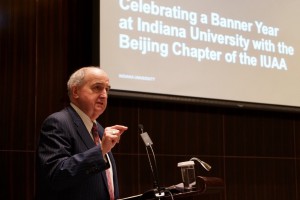Celebrating Elinor Ostrom and IU’s continuing engagement with China
Several years ago, and about a half dozen years before Elinor Ostrom became the first — and still only — woman to win the Nobel Prize for Economics, I was fortunate to have had the opportunity to interview the distinguished IU professor in her modest, unassuming office on the Indiana University Bloomington campus. Before leaving for the meeting, a science writer colleague of mine (I normally covered the arts), gave me a quick primer on the political scientist’s path-breaking research on public policy, public administration and, most notably, the economic governance of common pool resources. But the crash course failed to make me feel better, and on my walk over to Ostrom’s office I fretted over how soon I would be exposed as someone completely ill-informed about such serious and important research.
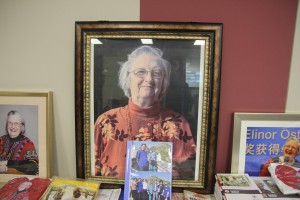
Materials displayed at a symposium at the IU China Gateway office in Beijing on the groundbreaking work of the late IU Nobel Laureate Elinor “Lin” Ostrom.
As it turned out, Lin, as she was more commonly known, could not have been nicer, kinder or more patient. That day, she gave generously several hours of her time, walking me through years of scholarship in understandable, enlightening and, ultimately, fascinating fashion.
When the news arrived in 2009 that Lin was going to be awarded the Nobel Memorial Prize in Economic Sciences for her work on the commons, I, along with the rest of the IU community, felt immense pride in the fact that one of our own had scaled such extraordinary heights. And like so many other Hoosiers, I marveled at the remarkable level of her stardom. Now, more than four years after her death, she remains one of the most shining reflections of the depth, breadth and quality of education and research at IU, as well as the impact of the university’s engagement nationally and internationally.
‘The legacy of Lin’
Memories of my brief waltz into Lin’s world and her litany of achievements came flooding back to mind this morning here in Beijing, as IU President Michael A. McRobbie delivered the welcoming remarks at the Ostrom Symposium on the Study of the Commons, Governance and Collective Decision, held at the IU China Gateway office. Hosted by IU’s Research Center for Chinese Politics and Business — which is led by IU School of Public and Environmental Affairs professor Joyce Man, who is also the academic director of the IU China Gateway — and the Chinese Ostrom Society, the conference included some 75 or so attendees, many of whom are distinguished Chinese students and scholars who have been greatly influenced by the theories and methods associated with and developed by Lin and her late husband, Vincent. These students and scholars are also carrying on what might be described as “the legacy of Lin” through their own accomplished work around the globe as writers, researchers, development practitioners, advisers and more.
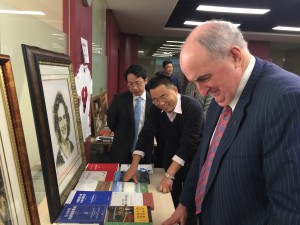
IU President Michael A. McRobbie surveys a collection of photos and works related to the late IU Nobel Laureate Elinor Ostrom.
As President McRobbie explained in his welcoming remarks, Lin had a “profound impact” on development studies around the world, and she was largely responsible for the development of the study of the commons, a field that has exploded over the past quarter century. Her seminal book, “Governing the Commons,” dispelled conventional wisdom that the best arrangement for managing common property was either privatization or government control. And over nearly five decades of teaching and research at IU’s Workshop on Political Theory and Policy Analysis, which she and Vincent co-founded and is now named in their honor, she employed a combination of social science methodologies and field research to reveal the capacity of people in local communities to solve their own problems with appropriate assistance.
Today’s conference illustrated the far-reaching nature of Lin’s legacy, which continues to thrive here in China. You might say Lin is somewhat of a rock star here. (Not to make light of it, but the gateway office looked a little today like the outside of Elvis’ Graceland, the walls lined with large photos of Lin and Vincent, dozens upon dozens of translated books and, best of all, several T-shirts with Lin’s face emblazoned on them, one of which was presented to McRobbie after his remarks.)
The Ostroms first visited China in 1997 and returned in 2007, 2009 and 2011 to participate in conferences and give lectures across the country. During these trips they visited many of China’s top universities and academies, including Tsinghua University, Renmin University, Peking University and the China University of Political Science and Law in Beijing, as well as at Sun Yat-Sen University in Guangzhou. Former students and scholars affiliated with the workshop that Lin and Vincent founded in 1973 now have faculty positions at all of these universities.
Many of those attending today’s conference were members of the Chinese Ostrom Society, founded in 2009 to study and analyze the Ostroms’ ideas and methods on resource management and polycentric governance. The society features several scholars who have worked to translate Lin’s many writings into Chinese, including Wang Jianxun, an IU alumnus now on the faculty of the China University of Political Science and Law, and professor Mao Shoulong of Renmin University, whose team of writers has translated almost all of the Ostroms’ core works (more than a dozen books) and facilitated their publication in China.
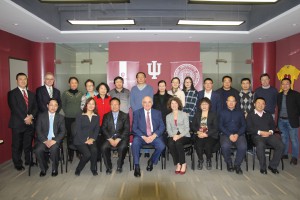
IU President McRobbie and members of the delegation with participants at the Ostrom Symposium at the IU China Gateway office.
More broadly speaking, Lin’s work has had a major impact on public policy circles in China and has been cited by Chinese scholars writing on topics such as forestry management, water resource management, and political and institutional economics. And as McRobbie indicated, her ideas on governing common pool resources will almost certainly continue to be crucial here, as the country works to manage its commons in the face of rising expectations and demand.
At the conclusion of his remarks, McRobbie thanked the “big family” in China for their presence at today’s symposium and their efforts to burnish Lin’s and her husband’s shared legacy.
“Their remarkable legacy endures through the work of scholars like all of you, who carry on their work by asking constructive questions that challenge conventional wisdom; by gathering empirical data and conducting research that can influence decision-makers in business, government and civil society; and by inviting us all to consider new perspectives on critical issues.”
Meeting with the ‘MIT of China’
Lin and Vincent would have been deeply gratified by the events and activities in which McRobbie and members of the IU delegation took part following Wednesday’s symposium and which suggested the strength of IU’s engagement here in China now and for the foreseeable future.
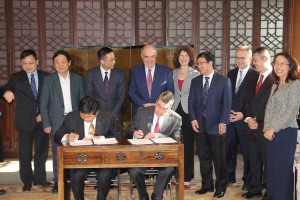
IUPUI School of Engineering Dean David Russomanno, seated right, signs a new agreement between the school and Tsinghua University that will lead to joint research on autonomous cars.
Upon leaving the symposium, the delegation headed to nearby Tsinghua University, which is consistently regarded as China’s top-ranked university. IU and Tsinghua, widely known as the MIT of China, have had a productive decade-long partnership focused on student exchanges and cooperative research; in 2014, IU dedicated its China Gateway office in the CERNET Tower in Tsinghua’s Science Park. In 2011, McRobbie participated in Tsinghua’s Global Education Conference, part of the university’s bicentennial celebration.
For nearly two decades, the Indiana University-Purdue University Indianapolis campus has enjoyed a productive partnership with Tsinghua’s Department of Automotive Engineering focused on advanced hybrid and electric vehicles. This led to the establishment, in 2006, of the Transportation Active Safety Institute at IUPUI, a collaborative university, industry and government consortium to facilitate research in advanced active safety systems and technologies as well as automated and autonomous vehicles. Over the years, TASI has established academic partnerships with a number of leading academic automotive safety research centers in the U.S. and with Tsinghua.
While at Tsinghua, McRobbie met with Tsinghua Vice President Qiu Yong to discuss the partnership between their respective research universities. They also discussed possibilities for further strengthening the collaboration, including Tsinghua’s interest in welcoming more IU students studying in areas such as informatics, computer science and art and design to China, which ranks among the top countries where IU students study abroad. The two leaders then witnessed the signing of a new partnership agreement between IUPUI’s School of Engineering and Technology, represented by Dean David Russomanno, and Tsinghua’s Department of Automotive Engineering that will lead to joint research on autonomous cars and what these vehicles, capable of sensing their environment and navigating with no human input, their technological challenges and what they mean to the future of human mobility.
Later Wednesday afternoon, McRobbie also delivered a talk to Tsinghua faculty and students about the role of the world’s top universities in the preservation of knowledge in the digital age. In his remarks, McRobbie presented IU’s leadership in a number of large-scale and wide-ranging digitization projects over recent years, including partnerships with, among other organizations, IBM, Google, the Naitonal Science Foundation and the HathiTrust, which IU co-founded with the University of Michigan. He also described IU’s Media Digitization and Preservation Initiative, an ambitious initiative established in 2013, aimed at preserving the university’s extensive collection of audio, video and film holdings by IU’s bicentennial anniversary in 2020.
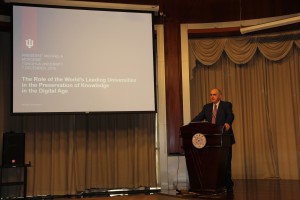
President McRobbie discusses the preservation of knowledge in the digital age during a talk at Tsinghua University.
Finally, the IU delegation made a brief stop at the magnificent and newly opened Tsinghua University Art Museum, which houses several centuries of Chinese painting and calligraphy, embroidery, porcelain, furniture, bronze ware and other artwork. With little time to see everything, the delegation spent about an hour touring a new exhibition on the work of Leonardo da Vinci, the largest public display of da Vinci’s authentic original sketches outside of Italy. The exhibition features 60 original sketches from the Codex Atlanticus, the largest collection of da Vinci’s papers ever assembled, along with his design models and his famous early-17th-century oil painting of The Last Supper.
The power of IU’s Chinese alumni
I could go on and on, of course, about IU’s strong partnerships with Tsinghua and other leading educational institutions in China; IU’s acclaimed programs in Chinese culture, history and languages; its flagship center in Mandarin, one of the few funded by the U.S government; and much more. But the story of IU’s engagement in China could not be complete without a few words about the university’s ever-increasing alumni engagement, particularly here in Beijing.
IU now has more than 5,800 alumni affiliated with China, and they continue to be a vital part of the life and impact of Indiana University around the world.
Tonight, President McRobbie and IU delegation members had the opportunity to meet with about 100 of the IU Alumni Association’s Beijing-based alumni, who constitute a rapidly growing alumni chapter and who were eager to hear about all of the many happenings back home in Indiana.
Fulfilling their wish, McRobbie described a banner year at IU, including several record-breaking achievements across the university. He also shared news of some exciting activities directly related to China, including the broadcasting of IU basketball games in Mandarin on IU’s athletics website, a development which, not surprisingly, many of our alumni were already well aware.
Perhaps most notably, he talked at length about the launch of a new global arts and humanities festival next spring at IU Bloomington, which, in its inaugural year, will focus on China, Taiwan, Hong Kong and the Chinese-American community in the U.S.
The theme of the festival will be “China Remixed,” and it will focus on contemporary Chinese arts and culture as they relate to today’s world through campus-wide exhibits, performances, film screenings and lectures. It will be the largest festival dedicated to Chinese arts and culture ever hosted in the Midwest, featuring world-renowned scholars, journalists, artists, musicians and writers, including the celebrated Chinese writer Ha Jin.
Among its many highlights, the festival will also feature a performance of Thunderstorm 2.0, a play ranked as one of the best performances in China in the past several decades in which a large crew joins actors on stage during the performance, creating a movie that is edited and screen above the stage in real time. It will also include a showcase of work from Beijing’s acclaimed 798 Art Zone attraction, as well as a groundbreaking exhibition on the Quilts of Southwest China at IU’s Mathers Museum of World Cultures, one of a number of organizations on IU’s campuses with growing cultural and research links to this part of the world.
As the hour approached 10 p.m. local time, the celebration, now going on three hours, continued with many happy and proud alumni lining up to shake hands, share stories and even take several selfies with President McRobbie. One truly couldn’t have asked for a more perfect ending to a busy, exciting and productive day, one that offered strong testimony to the ever-expanding power of an IU education from Bloomington to Beijing and everywhere in between.
Tags: Beijing, China, China Remixed, David Russomanno, Elinor Ostrom, Indiana University Alumni Association, IU Athletics, IU China Gateway, IU Mathers Museum of World Cultures, IU Media Digitization and Preservation Initiative, IUPUI School of Engineering and Technology, Joyce Man, Michael A. McRobbie, Tsinghua, Tsinghua University, Vincent Ostrom



